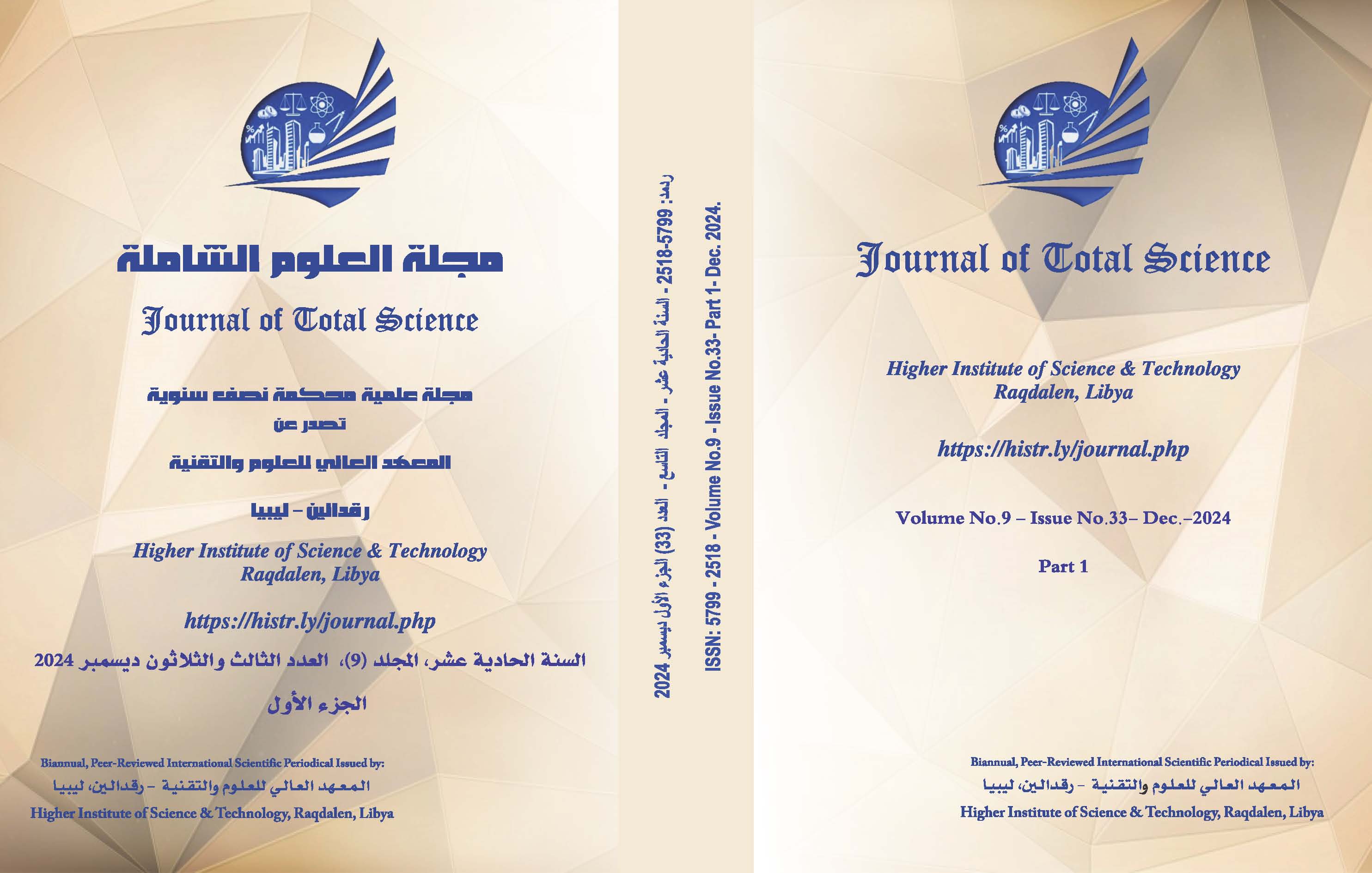The impact of Using AI Tools in Developing and Hindering 21st Century Skills Among ESL Students: a review article
الكلمات المفتاحية:
Artificial intelligence (AI)، 21st-century skills، English as a Second Language (ESL)الملخص
Incorporating artificial intelligence (AI) tools in education has revolutionised how students learn. Artificial intelligence )AI (enables customised learning experiences and improves teaching strategies; as a result, teachers can dedicate more time to engaging with students and providing assistance, which can lead to better overall educational results, particularly for English as a Second Language (ESL) students. Despite the benefits of AI tools, this qualitative literature review paper explores the dual impact of AI tools on the development and destruction of essential 21st-century skills, including critical thinking,
collaboration, creativity, and communication. On the other hand, notable challenges include over-reliance on technology, reduced interaction and interpersonal communication, and a decline in critical thinking abilities. This study highlights the advantages and challenges of using AI in ESL contexts by reviewing recent literature. The key findings underscore the importance of a balanced approach to integrating AI tools into ESL curricula to optimise educational outcomes. This review synthesises current research and offers actionable recommendations for educators to leverage AI in language learning settings effectively.
التنزيلات
المراجع
Baker, R.S., & Inventado, P.S. (2014). Educational data mining: An overview of the state of the art. Journal of Educational Data Mining, 6(1), pp. 1-15. Available at: http://www.educationaldatamining.org (Accessed: 24 November 2024).
Baker, R.S., Inventado, P.S., & D'Mello, S.K. (2019). Educational data mining and learning analytics. In: Handbook of Educational Data Mining. CRC Press. Available at: https://www.crcpress.com (Accessed: 24 November 2024).
Chen, L. & Zhang, Y. (2023). 'AI-assisted language learning: A review of the current literature', Language Learning & Technology, 27(1), pp. 45–67. Available at: llt.msu.edu (Accessed: 24 November 2024).
Chen, L., & Zhang, T. (2023). The effectiveness of AI-driven platforms in enhancing ESL learning outcomes. Journal of Language Teaching and Research, 14(1), pp. 45-58. Available at: https://www.jltr.org (Accessed: 24 November 2024).
Chen, X. (2022). The Role of AI in Language Learning: A Study of Chatbot Effectiveness. Journal of Language and Linguistic Studies, 18(2), 45–60. Available at: https://www.jlls.org (Accessed: 24 November 2024).
Dale, L. (2021). Chatbots in education: A review of the current state and prospects. International Journal of Educational Technology, 15(2), 45–62. Available at: https://www.ijet.org (Accessed: 24 November 2024).
Duffy, T.M., Fisher, D.L. & Jones, J.E. (2020). 'Collaborative learning environments and social presence', International Journal of Educational Technology in Higher Education, 17(1), pp. 1–15. Available at: ijet.org (Accessed: 24 November 2024).
Garcia, R. (2023). 'Speech recognition technology in language learning: Impacts on ESL students', International Journal of Educational Technology, 29(2), pp. 123–139. Available at: ijet.org (Accessed: 24 November 2024).
Godwin-Jones, R. (2018). 'Using mobile technology to develop language skills', Language Learning & Technology, 22(3), pp. 1–10. Available at: llt.msu.edu (Accessed: 24 November 2024).
González, A. and Lee, J. (2021) 'The Role of AI in Language Learning: A Review of Current Trends', International Journal of Educational Technology, 17(2), pp. 123–135. Available at: ijet.org (Accessed: 24 November 2024).
González-Gómez, F. et al. (2020) 'Gamification in education: A systematic review', Educational Technology & Society, 23(1), pp. 15-29. Available at: etsjournal.org (Accessed: 24 November 2024).
Graham, C.R. (2019). 'Blended learning systems: Definition, current trends, and future directions', in The Handbook of Blended Learning: Global Perspectives, Local Designs. Pfeiffer Publishing. Available at: pfeiffer.com (Accessed: 24 November 2024).
Gulson, K. N., & Symes, C. (2007). Spatial theories of education: Policy and practice. Routledge.
Hwang, G. J., & Chang, C. Y. (2019). A review of mobile technology in education: Current trends and future directions. Educational Technology & Society, 22(4), 25–35.
Hwang, G. J., & Chang, T. H. (2019). Innovative learning environments in the age of AI: Overview and future directions. Educational Technology & Society, 22(2), 1-10.
Hwang, G. J., & Chen, C. H. (2020). Smart Learning Environments: The Role of Artificial Intelligence in Education. Computers & Education, 154, 103909.
Hwang, G.J. & Chang, C.Y. (2019). 'A review of mobile technology in education: Current trends and future directions', Educational Technology & Society, 22(4), pp. 25–35. Available at: etsjournal.org (Accessed: 24 November 2024).
Johnson, D. W., & Johnson, R. T. (2019). Cooperation and the Use of Technology. Educational Technology Research and Development, 67(4), 789–802.
Johnson, D. W., Johnson, R. T., & Holubec, E. J. (2021). Cooperation in the Classroom. Boston: Allyn & Bacon.
Johnson, D.W. & Johnson, R.T. (2019). 'Cooperation and the Use of Technology', Educational Technology Research and Development, 67(4), pp. 789–802. Available at: springer.com (Accessed: 24 November 2024).
Johnson, D.W., Johnson, R.T. and Holubec, E.J. (2021). Cooperation in the Classroom. Boston: Allyn & Bacon. Available at: pearson.com (Accessed: 24 November 2024).
Johnson, M. (2022). Collaborative learning in the AI era: Enhancing teamwork skills in ESL education. Educational Research Review, 18(3), 201–216.
Kapp, K. M. (2012). Gamification: Separating fact from fiction. ASTD.
Krashen, S. (1982). Principles and practice in second language acquisition. Pergamon Press.
Kukulska-Hulme, A. (2020). 'Will Mobile Learning Change Language Learning?', Language Learning & Technology, 24(2), pp. 1–8. Available at: llt.msu.edu (Accessed: 24 November 2024).
Kukulska-Hulme, A., & Shield, L. (2020). An Overview of Mobile Assisted Language Learning. Language Learning & Technology, 24(2), 2-14.
Lai, M. (2020). 'The role of AI in language education: A review', Language Learning & Technology, 24(2), pp. 40–52. Available at: llt.msu.edu (Accessed: 24 November 2024).
Lai, M. J., et al. (2021). Gamification in Language Learning: A Review of the Literature. Journal of Educational Technology & Society, 24(3), 25-37.
Lee, S. (2022). 'Personalised Learning through AI: Enhancing ESL Education', Journal of Language and Linguistic Studies, 18(1), pp. 45–59. Available at: jlls.org (Accessed: 24 November 2024).
Li, J., Zhang, Y. & Wang, R. (2022). 'Personalised Learning through AI: Enhancing Language Acquisition in ESL Students', Journal of Language Learning Technologies, 34(2), pp. 115–130. Available at: jllt.org (Accessed: 24 November 2024).
Li, L., Zhang, Y., & Wang, Q. (2023). The Impact of AI Tools on ESL Writing Skills: A Study of Student Perceptions. Language Teaching Research, 27(3), 301–320.
Li, M., & Wang, Y. (2021). "The role of collaboration in language learning using AI tools." Journal of Language Teaching and Research, 12(4), 557-564.
Liu, Y., Wang, J. & Zhao, H. (2022). 'AI chatbots as language partners: A study on ESL communication skills', Language Learning & Technology, 26(4), pp. 34–50. Available at: llt.msu.edu (Accessed: 24 November 2024).
Luckin, R. et al. (2016). Intelligence Unleashed: An Argument for AI in Education. Pearson Education. Available at: pearson.com (Accessed: 24 November 2024).
Martinez, L. (2023). 'The Impact of AI on Communication Skills in ESL Learners', TESOL Quarterly, 57(3), pp. 789–805. Available at: tesol.org (Accessed: 24 November 2024).
Miller, A. (2023). 'The creativity paradox: AI assistance and its effects on student originality', Creativity Research Journal, 35(1), pp. 12–22. Available at: tandfonline.com (Accessed: 24 November 2024).
Miller, J., & D'Amico, A. (2021). Creativity in the Age of AI: Challenges and Opportunities for Language Learners. TESOL Quarterly, 55(4), 887-902.
Miller, K., & D'Amico, J. (2021). The role of creativity in language learning: Challenges and opportunities in a digital age. Language, Culture and Curriculum, 34(3), 275-290.
Nguyen, T. & Hsieh, Y. (2023). 'Cultural Contexts in AI-Assisted Language Learning', Language, Culture and Curriculum, 36(1), pp. 55–72. Available at: tandfonline.com (Accessed: 24 November 2024).
Nguyen, T., & Tran, H. (2022). The Effects of AI on Critical Thinking in ESL Education. Educational Review, 74(6), 745-762.
Partnership for 21st Century Skills (2019). Framework for 21st Century Learning. Available at: P21.org (Accessed: 24 November 2024).
Patel, S. (2023). 'The social implications of AI in language learning: A focus on ESL students', Journal of Applied Linguistics, 11(2), pp. 78–92. Available at: jal.org (Accessed: 24 November 2024).
Shearer, R. (2021). 'Embracing the challenges of teaching with AI', Journal of Educational Technology Systems, 49(1), pp. 45–56. Available at: jet.sagepub.com (Accessed: 24 November 2024).
Smith, A. & Jones, B. (2023). 'The Risks of Over-Reliance on AI in Language Learning', International Journal of Educational Technology, 15(1), pp. 45–60. Available at: ijet.org (Accessed: 24 November 2024).
Smith, J. (2020). Adaptive learning technologies and their impact on ESL education. TESOL Quarterly, 54(3), 456–470.
Smith, J., & Lee, K. (2023). Gamification and critical thinking in AI-enhanced learning environments. Journal of Educational Psychology, 115(4), 455–470.
Smith, J., et al. (2020). The Impact of AI on Social Skills Development in Education. International Journal of Educational Research, p. 102, 101586.
Thompson, M. (2023). Enhancing student engagement through AI tools: A case study in higher education. Journal of Interactive Learning Research, 34(1), 67–85.
Thompson, R. (2022). 'Over-reliance on AI tools in language education: Consequences and considerations', Modern Language Journal, 106(3), pp. 293–307. Available at: wiley.com (Accessed: 24 November 2024).
Thompson, R. (2023). Gamification in Language Learning: Effects on Motivation and Retention. Journal of Educational Psychology, 115(2), 299–310.
Thorne, S. L. (2020). The Social Turn in SLA: Implications for Language Learning and Teaching. Applied Linguistics, 41(3), 321-339.
Thorne, S.L., et al. (2018). "The role of technology in language learning." Language Learning & Technology, 22(1), 1-6.
Wang, Y., et al. (2023). The Influence of AI Assistance on Student Learning Outcomes. Computers in Human Behavior, 132, 107-115.
Woolf, B.P. (2010). Building Intelligent Interactive Tutors: Student-centered Strategies for Revolutionizing E-learning. Morgan Kaufmann. Available at: elsevier.com (Accessed: 24 November 2024).
Zhang, Y. (2020). 'The role of AI in fostering critical thinking in ESL classrooms', International Journal of English Language Education, 8(1), pp. 1–15. Available at: ijele.org (Accessed: 24 November 2024).
Zhang, Y. (2020). Collaborative Learning in the Age of AI: Opportunities and Challenges. Educational Technology Research and Development, 68(3), 1021–1035.
Zhao, Y. (2021). 'AI and Creativity: The Potential and Pitfalls', Creativity Research Journal, 33(2), pp. 150–160. Available at: tandfonline.com (Accessed: 24 November 2024).
منشور
إصدار
القسم
الرخصة

هذا العمل مرخص بموجب Creative Commons Attribution-NonCommercial-ShareAlike 4.0 International License.










